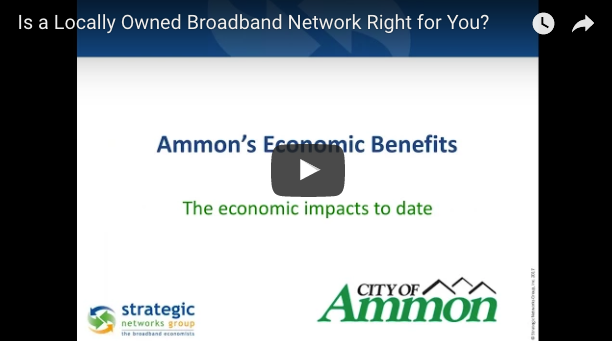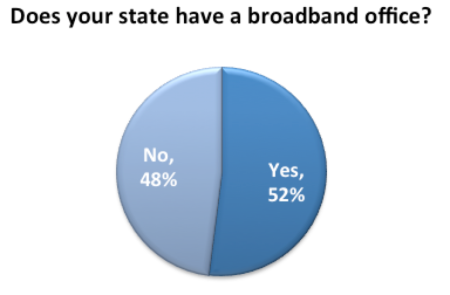 The long-running debate over whether municipalities can build their own Internet networks is more rooted in ideological positions than pragmatism. Should a tax-supported municipality be using its resources to compete with private ISPs? Opinions are often rooted in ideals of whether to let the free market take care of it or to invest public resources. Moving past ideology allows the discussion to address the needs and concerns of both sides of the debate.
The long-running debate over whether municipalities can build their own Internet networks is more rooted in ideological positions than pragmatism. Should a tax-supported municipality be using its resources to compete with private ISPs? Opinions are often rooted in ideals of whether to let the free market take care of it or to invest public resources. Moving past ideology allows the discussion to address the needs and concerns of both sides of the debate.
There are legitimate concerns expressed by opponents of municipal broadband (the private sector) which primarily revolve around the taxpayer risks of committing public resources to build and operate a network. Unfortunately opponents tend to paint a black and white picture, pointing to examples of municipal broadband failures and using this to reinforce a position that public entities should not be competing in the free market.
Broadband investment carries with it risk as they are by no means inexpensive to build. Some municipalities have been successful in rolling out a community broadband network while others have failed. But let’s be clear about the real issues driving municipalities in this direction.
No municipality wants to become an ISP. Municipal networks are the result of a city/town filling service needs where the private sector has not and/or will not. These communities recognize that if service gaps remain unaddressed, they will increasingly have negative effects on the local economy and the overall well-being of their community.
Unfortunately, the muni broadband debate always seems to center on whether or not the network can become a viable and sustainable ISP while competing with incumbents. The reality is that if there was a really good business case for building out and upgrading networks, the incumbents would have done so already. The rationale for municipal broadband networks goes beyond the traditional ISP business case and must also be based on economic development, social equity, and the ability to control a community’s own destiny in the digital world. Advancing communities through broadband is not in an ISP’s mission statement – nor should it be.
Evidence clearly shows that better broadband, when used meaningfully, brings communities tremendous economic benefits. Unfortunately this is generally overlooked when debating viability or sustainability as the go/no-go devolves to a narrow “business case” argument and assessing taxpayer risk.
Fortunately there’s another way to address municipal needs while mitigating many of the issues and risks – a middle way, both figuratively and literally. That middle way is to treat broadband as essential infrastructure, similar to providing clean water and roads with which municipalities are very familiar. Taking an essential service approach with broadband can also avoid directly competing in the retail ISP market. How would this work?
First, the municipality can invest in their own network for their own needs, something they have every right to do and often need to do for operational purposes. This can be a relative small initial investment to establish a core network to reduce costs to connect their own facilities as well as community anchor institutions, such as schools and libraries. The payback may be over a number of years, but the core network has a starting point.
Once the core network is in place it can be extended to serve residents and businesses that lack broadband at all or have to settle for low-speed, low-reliability options from incumbents. A big investment? Yes, if you consider the whole community. However, there is a viable model that reduces the payback risk using broadband improvement districts. Essentially, this is a neighborhood where property-owners opt-in to own the local network infrastructure. Households pay up front on terms that are financed in such a way that their monthly Internet costs are reduced from what they pay now. This is the model that Ammon, Idaho, is using.
This is a win-win scenario as additional municipal network investment is paid up-front by committed property owners who also save money monthly and receive significantly better broadband service. By offering only the infrastructure on an open basis the municipality can encourage other retail service providers to offer services at affordable rates over it. Property owners not only save money but have more competitive choice on a high capacity network.
The municipality benefits further by eliminating the risk of directly competing on a retail basis with incumbents. This also eliminates taxpayer risk by only building based on committed demand by property owners that opt in. By focusing on building infrastructure rather than being a retail ISP, regulatory constraints can be avoided.
In fact, not only do municipalities avoid competing with other ISPs, a major critique of municipal broadband networks, this approach actually increases competition among a wider range of ISPs – something that free-market proponents should welcome.
The end result is that the municipality gains sorely needed broadband infrastructure, building it in an inherently sustainable way without assuming the financial or political risks normally associated with the retail municipal network approach. Furthermore, this “pay as you go” approach can potentially work for even small communities that do not have the market size to support the retail municipal broadband model.
The reality is that there are still many communities, especially in rural America, that suffer from a lack of affordable broadband of any type or have what is fast becoming antiquated technology. Such communities are at a disadvantage and risk losing economically with erosion of their population and businesses. The incumbent ISP business case status quo will not change. Communities need to take action and assume control of their own broadband destiny with this essential infrastructure. There is a way forward.
 One-of-a-Kind Offering Provides Initial Insights into the Feasibility of a Locally Owned Network by Weighing Costs and Benefits
One-of-a-Kind Offering Provides Initial Insights into the Feasibility of a Locally Owned Network by Weighing Costs and Benefits
Dallas, Texas – Today at the Broadband Communities Summit Strategic Networks Group (SNG) announced its new service, the Economic Feasibility Assessment. SNG’s Economic Feasibility Assessment is SNG’s lower-cost, relatively rapid alternative to the traditional feasibility study. It’s a preliminary step to inform and develop a plan for local broadband investment. The Economic Feasibility Assessment uncovers whether a community should invest by quantifying the benefits to be realized in a “what-if” scenario of a locally owned network. SNG investigates real community savings versus investment required and as a value-add offer a forecast for the economic growth a new network could facilitate. The economic investment estimates are provided by leading industry firm AEG.
“We’re delighted to partner with SNG in this endeavor to help municipalities quickly ascertain if they should move forward with a broadband network,” said James Salter, Chairman of AEG. “Too many communities feel stuck and forced to do a deep dive with a traditional feasibility study when the first step should be understanding the overall costs and potential local benefits a network could provide before taking that step.”
“We’re simply taking the time to quantity costs and savings as well as uncovering potential community benefits from broadband investments to see if initial analysis shows a return on investment,” explains Michael Curri, president and founder of SNG. “In less than a month for a fraction of the cost of a feasibility study, communities can quickly understand if they should move forward, abandon the premise altogether, or conduct more legwork.”
The Economic Feasibility Assessment includes:
- Estimate of network investment (provided by Atlantic Engineering)
- Potential municipal cost reductions compared to existing broadband costs.
- Cost benefits for community anchor institutions (schools, libraries, hospitals, government buildings).
- Cost savings for households and the accompanying consumer surplus for local spending.
- Economic growth from increased business competitiveness and productivity.
To read the Economic Feasibility Assessment for Ammon Idaho, visit www.sngroup.com/ammon.
About Strategic Networks Group (SNG)
Focused on economic advancement through broadband utilization, SNG is a group of broadband economists who develop strategies for most effectively leveraging broadband investments. SNG addresses broadband utilization from the individual organization level all the way up to working with more than 10 ten states across the United States. SNG looks to help make the most broad-reaching and transformational impacts that broadband can bring to enable businesses, communities and regions by delivering the data and analysis decision makers need to maximize broadband’s potential. Learn more about SNG at www.sngroup.com.
 About Atlantic Engineering Group (AEG)
About Atlantic Engineering Group (AEG)
AEG offers a full suite of services that aid clients in the successful implementation of their broadband networks. We pride ourselves in innovative client deployments and even developed our corporate culture to support the exploration of all possible methods. Our end goal is to find the best solution for each client. Visit AEG inline at www.aeg.cc.

SNG Examines the Economic Impacts of a Locally Owned Network
In advance of SNG’s announcement next month of an exciting new offering called the Economic Feasibility Assessment, SNG’s analysis was featured in the pre-Broadband Summit issue of Broadband Communities Magazine. Included in Michael Curri’s article, “A Local Ownership Approach to Broadband” is a deep dive on a case example (Ammon, ID) and the benefits. It’s a deep dive to explain how a locally owned network can pay for itself, saving the municipality, businesses, and households money.
This article is based on the cost and benefits a locally owned network brought to the City of Ammon, Idaho. The Broadband Benefits Assessment is an application of SNG’s Economic Feasibility Assessment – a pragmatic alternative to longer and more costly feasibility studies. It is foundational to a sustainable project and first planning step because it answers the key question: Do the benefits of this broadband infrastructure investment for our community/region outweigh the costs? The Broadband Benefits Assessment applies this methodology to broadband investments that have already been made (i.e. ex-post).
 The Broadband Benefits Assessment Report includes:
The Broadband Benefits Assessment Report includes:
- Cost summary of network investment.
- Municipal cost reductions compared to prior broadband and telecommunications costs.
- Cost reductions for community anchor institutions (schools, libraries, hospitals, government buildings) compared to prior broadband and telecommunications costs.
- Cost savings for households and the accompanying consumer surplus for local spending.
- Economic growth from increased business competitiveness and productivity.
- Smart community service benefits.
Any community considering taking its broadband future into its own hands needs to understand and quantify the economic and community benefits such an investment would require. In some cases, municipal cost reductions alone outweigh the costs of building digital infrastructure.

Read Ammon, Idaho’s Broadband Benefits Assessment Report
Watch the Webinar: Is a Locally Owned Broadband Network Right for You?

Uncovering State-by-State Broadband Activities and Investments
UPDATE: In February of 2017 SNG provided an update to this report.
Today in conjunction with the Rural Telecommunications Congress (RTC), Strategic Networks Group (SNG) released its first of its kind report on broadband investment and activity by American States. The report, available at sngroup.com/states combines FCC availability and adoption figures with SNG’s survey results of 48 states to rank states on the following dimensions: Availability, Adoption, Driving Meaningful Use, Growth Investment, and Regulation.

Download the report>>
“We put a great deal of time into determining the dimensions and how to measure each,” explains Michael Curri, SNG’s Founder and President. “There’s so much more to being competitive in a digital economy than merely providing fiber/higher speeds.”
Ranking each state with a weight for each category yielded the following as the top 5 states in terms of broadband; New York, Ohio, Maine, New Mexico, and New Hampshire.
Some highlights of the findings include:
- 52% of states have an office dedicated to broadband
- Only a little more than a quarter (28%) definitely have a budget to fund broadband initiatives
- Activities most often funded by states are “planning and support” (82% of funded states) and infrastructure (45%).
“One overall finding that was interesting is that investment activities seem to be heavily weighted towards the “supply” of broadband and include mapping, infrastructure planning, and grants, surpassing economic development activities that impact economic advancement including raising awareness, training, and driving end-user utilization,” explains Curri.
Key contributors to this initiative were:
- Doug Adams, Strategic Networks Group
- Michael Curri, Strategic Networks Group
- Lori Sherwood, Vantage Point Solutions
- Gary Dunmore, Strategic Networks Group
- Monica Babine, Washington State University
- Maria Alvarez-Stroud, University of Wisconsin-Extension
About Strategic Networks Group (SNG)
Founded in 1998, Strategic Networks Group (SNG) helps communities and regions transform local economic opportunities, quality of life, and access to essential services through broadband and digital infrastructure. For nearly two decades Strategic Networks Group has been helping communities and regions focus on the ‘demand side’ of broadband, digital infrastructure, and transformation because benefits are the drivers for technology investments – such as a municipality saving 86% in telecommunication and internet costs. SNG is agnostic to technology and network business models which are the ‘supply side’ of broadband. Our mission is to help communities and regions get the best value for their ratepayers from technology investments and to maximize sustainable economic development opportunities in an increasingly digital world. Learn more about SNG at www.sngroup.com.
About Rural Telecommunications Congress (RTC)
The Rural Telecommunications Congress (RTC) is a national membership organization dedicated to assuring that rural areas in the United States have access to the information and support they need to obtain and use advanced telecommunications services and technology for social and economic development. Visit RTC online at www.ruraltelecon.org.
If you would like to download the entire report, click here>>
For questions, clarification, or to make sure your state is fully represented in our study, email states@sngroup.com.
Leveraging Financial Impacts Data from Tens of Thousands of American Businesses, SNG Can Show Regions the Power of Programs that Look “Beyond Availability” and Drive Internet Utilization
Strategic Networks Group (SNG) today announced an innovative model for estimating economic impacts generated from increasing businesses’ meaningful use of Internet applications.
The model was developed because broadband’s economic impact is shown to be marginal without meaningful use by businesses. Furthermore, SNG’s research shows the majority of businesses are underutilizing Internet applications – foregoing growth opportunities. The smaller the business (90% of US businesses are classified as small businesses), the less they’re using broadband’s applications. The opportunity cost to communities and regions are unrealized economic benefits.
SNG’s new Broadband Economic Impact Model estimates the potential economic growth from increased broadband use. The model uses quantitative analysis to reveal the potential economic impacts from broadband for your region based on a variety of broadband utilization scenarios. Powering this model is SNG’s extensive research from tens of thousands of businesses that have reported Internet utilization and accompanying financial impacts.
“As states and municipalities focus on ensuring the necessary broadband infrastructure to create and foster economic growth, more and more regions have come to us wondering how to ensure broadband’s benefits are realized,” explained Michael Curri, president of SNG. “The Broadband Economic Impact Model actually projects what meaningful use of broadband can mean for job creation, business growth, and increased tax revenues.”
For those who want to look beyond a laissez-faire approach to economic development through broadband, the model empowers regions and states to develop strategies to drive meaningful use and proactively create growth.
To see what the Broadband Economic Impact Model reveals about the economic growth potential meaningful use has in your region visit: www.sngroup.com/impacts.
US Federal POWER Initiative Funds to be Used to help Businesses and Displaced Coal Workers in Alabama, Mississippi, and Tennessee
 Superior, CO – Today, SNG and Shoals Entrepreneurial Center in Alabama announced that the Shoals Shift program will include SNG’s broadband benchmarking, business assistance, and workforce training programs. All of these efforts are focused on capitalizing on opportunities available through the Internet and its applications.
Superior, CO – Today, SNG and Shoals Entrepreneurial Center in Alabama announced that the Shoals Shift program will include SNG’s broadband benchmarking, business assistance, and workforce training programs. All of these efforts are focused on capitalizing on opportunities available through the Internet and its applications.
The Shoals Entrepreneurial Center received $997,000 in matching funds from the Appalachian Regional Commission’s POWER Initiative (Partnerships for Opportunity and Workforce and Economic Revitalization) to fund Shoals Shift. POWER is a federal program put in place to assist Appalachian communities with funding to assist coal communities transition to a new economy by ”cultivating economic diversity, enhancing job training and re-employment opportunities, creating jobs in existing or new industries, and attracting new sources of investment.”
Shoals Shift will utilize SNG’s comprehensive and industry-leading eSolutions Benchmarking to help develop digital strategies for the region. Also included in this three-year partnership will be the Small Business Growth Program, a program that shows businesses the economic impacts that inspire greater Internet application utilization, grow businesses, and create job opportunities.
Giles McDaniel, Executive Director of the Shoals Entrepreneurial Center explained that the grant will help accelerate the growth of a digital economy, “We plan to implement three interconnected strategies; 1) building an innovation discovery pipeline, 2) cultivating a culture of collaboration and entrepreneurship, and 3) strengthening existing businesses.”
“SNG’s programs are specifically designed to help businesses grow and create job opportunities,” explains Michael Curri, president of SNG. “We’re thrilled to be an integral part of helping the Shoals region transition to a digital economy.”
About Strategic Networks Group (SNG)
Focused on economic advancement through broadband utilization, SNG is a group of broadband economists who develop strategies for most effectively leveraging broadband investments. SNG addresses broadband utilization from the individual organization level all the way up to working with more than 10 ten states across the United States. SNG looks to help make the most broad-reaching and transformational impacts that broadband can bring to enable businesses, communities and regions by delivering the data and analysis decision makers need to maximize broadband’s potential. Learn more about SNG at www.sngroup.com.
About The Shoals Entrepreneurial Center
The Shoals Entrepreneurial Center (SEC) is a business incubator located in northwest Alabama. Business incubation is a proven tool for regional economic growth. Our business model has a 90% success rate. The Center supports start-up and emerging companies to help them successfully launch and grow. We offer a cluster of commercial space, technical assistance, and a wide-ranging network of partners to provide a critical framework to help entrepreneurs meet their business goals.
Why are broadband offices important? They are a focal point for any questions about broadband, a clearinghouse for information, a staging area for broadband projects, and they provide leadership on broadband issues. They’re critical to driving economic development through broadband.
Through our ongoing work with governments at all levels on broadband issues, which includes the “ Fifty States of Broadband” study, numerous discussions with state broadband offices, as well as regional and national authorities, we would like to share what we would consider “leading practices” for a broadband office.
 First of all… have a broadband office. This seems basic enough, yet in the US only half the states have an office dedicated to broadband. Furthermore, for those that have broadband offices, a number of them are in the state’s IT department. This may seem like a fit on the surface, but strategic broadband efforts need to include more than merely overseeing the technology of broadband. As a driver for economic advancement and improving quality of life, broadband by itself will not reach its potential without a broadband office addressing important needs for driving utilization including training. For example, most businesses – especially small businesses – do not understand how to fully capitalize on the Internet and its applications.
First of all… have a broadband office. This seems basic enough, yet in the US only half the states have an office dedicated to broadband. Furthermore, for those that have broadband offices, a number of them are in the state’s IT department. This may seem like a fit on the surface, but strategic broadband efforts need to include more than merely overseeing the technology of broadband. As a driver for economic advancement and improving quality of life, broadband by itself will not reach its potential without a broadband office addressing important needs for driving utilization including training. For example, most businesses – especially small businesses – do not understand how to fully capitalize on the Internet and its applications.
Broadband is a tool for economic development. A purposeful decision needs to be made so that broadband is managed within a framework policy makers are already familiar. Economic development provides that framework for this critical infrastructure. Additionally, no matter the size of the government entity, the broadband office/evangelist/leader should be a standalone entity, reporting directly to executive branch. Here are some key leading practices we’ve seen from the most effective broadband offices:
Leadership
A broadband office should establish strategies to improve both the availability as well as the utilization of broadband. This includes providing communities with the information, tools, and technical assistance for regional planning – and leadership assistance when requested. Unfortunately most broadband offices are currently stretched thin on resources to drive meaningful use of Internet applications and with it economic growth and improved quality of life.
Information and Resource Center
The best broadband offices serve as evangelists, knowledge centers, and clearinghouses of information. They field and answer questions from legislators, mayors, and local stakeholders. They serve as advisors and help set goals and objectives for their communities, sharing and promoting best practices and advice. If an answer is needed, the broadband office either has it – or will find it.
There is a tremendous opportunity to serve as a resource for citizens, but currently only twenty-seven percent providing digital literacy/technology training and twenty-five percent offering technology training for businesses.
Holistic Broadband Planning
Effective broadband planning cannot stop with simply mapping where broadband is available. Broadband offices need to have the funding and capacity to not only understand where broadband is available, but also to understand where there is active vs. latent vs. potential broadband demand. This will identify where there are gaps in digital inclusion, digital literacy, and technical capability – each of which are barriers to growth and need to be addressed specifically. Capturing data on broadband supply and demand informs smart strategies and drives economic advancement. Investments and action plans need to address both access and meaningful use of broadband – a holistic approach. It is the broadband office’s role to write a statewide plan and hire expertise to fill in the gaps and make the plan a reality. Finally, benefits need to be measured and tracked to ensure that expected benefits will be achieved through appropriate investments.
The fact is there is no ‘one size fits all’ solution for a broadband office. However, each successful broadband office we’ve studied is doing these things. Putting leading practices together with the funding needed is a necessary investment for growth in an economy that is increasingly online.
Yesterday the Tennessee Department of Economic and Community Development (TNECD) released a comprehensive report examining broadband supply and demand statewide.
When Tennessee first approached SNG late in 2015, the state was clear that there indeed were issues with sufficient broadband, especially in rural areas and that broadband was a “crucial factor in the economic success of their communities.” Tennessee was looking at answering several questions including:
- What should the state’s definition of broadband be?
- How many Tennesseans do not have access to broadband?
- What is the cost of bringing broadband to Tennesseans that do not have it?
- What are best practices and lessons learned for promulgating broadband from around the country?
This report is significantly different than the “standard” as it examines broadband using a holistic approach to assessing availability and need. It is the first time that both broadband supply and demand have been assessed at a state level.

 Offering Allows ISPs to Help Businesses Better Utilize Their High-Bandwidth Service
Offering Allows ISPs to Help Businesses Better Utilize Their High-Bandwidth Service
Nashville, Tennessee – Today at the FTTH Conference & Expo, Strategic Networks Group (SNG) announced a new way for ISPs to increase revenues and retain customers. The Broadband Checkup enables ISPs to distinguish themselves as a partner to local businesses by showing them, through third-party research, how better broadband can grow their business. The Broadband Checkup is an innovative marketing strategy for ISPs to differentiate themselves as well as good PR as the program demonstrates a collaborative partnership and desire to help local businesses grow.
The Broadband Checkup is a cost-effective, low-risk means for ISPs to provide customers with SNG’s popular “Digital Economy index (DEi) Scorecards.” Contained within these scorecards are recommendations and competitive intelligence on Internet applications to be adopted and the accompanying ROI. The scorecard benchmarks a business’ self-reported Internet use against its peers from SNG’s database of more than 40,000 businesses. By doing so, the DEi scorecard reveals the Internet activities a business’ peers (based on size and industry) are using, along with the average benefits in terms of new revenues and cost savings.
“The Broadband Checkup allows ISPs that are already providing businesses with better speeds exactly how to most effectively use their service,” explained Michael Curri, president and founder of SNG. “Beyond availability, the Broadband Checkup shows businesses what they could and should be doing online to be more competitive and increase their revenues.”
“ISPs who provide their community the Broadband Checkup distinguish themselves as community business partner, not just a vendor,” said Doug Adams, VP Communications. “The offering will create community goodwill, demonstrating partnership, and show that the ISP is invested in the community, its businesses, and helping them grow.”
For more information, visit sngroup.com/isp.
About Strategic Networks Group (SNG)
Focused on economic advancement through broadband utilization, SNG is a group of broadband economists who develop strategies for most effectively leveraging broadband investments. SNG addresses broadband utilization from the individual organization level all the way up to working with more than 10 ten states across the United States. SNG looks to help make the most broad-reaching and transformational impacts that broadband can bring to enable businesses, communities and regions by delivering the data and analysis decision makers need to maximize broadband’s potential. Learn more about SNG at www.sngroup.com.
Strategic Networks Group Surveys Broadband Initiatives in Nationwide Study; Ranks New York State First Overall
from New York State Website
Governor Andrew M. Cuomo today announced that Strategic Networks Group, a world leader in broadband econometrics, ranked New York State number one in the nation for broadband activity and investment. “The 50 States of Broadband” study surveyed broadband investment activities on a state-by-state basis and determined that New York State ranked first overall in availability, adoption, driving meaningful use, growth investment, and regulation.
“The New NY Broadband Program is laying the groundwork for a strong economy by connecting households and businesses in every corner of the state, enabling New York businesses to compete on the world stage,” Governor Cuomo said. “We are proud to be home to the most robust broadband program in the nation and this ranking further emphasizes our role as a leader in next-generation high-speed internet infrastructure.”
SNG conducted its study from February through March 2016 and provided states with an online survey to complete. 48 states participatedand each responder was asked to report on five key dimensions of broadband: availability, adoption, meaningful use, growth investment, and regulation. Responses were used to rank states on these dimensions and develop a composite overall ranking.
“The Broadband Program Office is excited that New York State was selected as the overall leader in broadband capability in the nation,” said Empire State Development Executive Vice President of Broadband and Innovation Jeffrey Nordhaus. “This acknowledgement underlines the Governor’s commitment to broadband, which is the boldest and most ambitious in the nation. While we are proud of the recognition, the BPO continues to be focused on delivering results for New Yorkers and looks forward to the results of the Phase One auction.”
The New NY Broadband Program is designed to ensure that every New Yorker has access to high-speed internet by 2018. The Program, along with the Public Service Commission’s order approving the merger of Time Warner Cable and Charter Communications, will significantly increase broadband availability for millions of New Yorkers across the state.
Central components of the Program include:
- New access to broadband at speeds of at least 100 Mbps; 25 Mbps in the most remote areas of the state.
- High priority for areas and projects that most improve broadband Internet access in unserved areas, including libraries and educational opportunity centers.
- Applications will be chosen through a “reverse-auction” process, which will award funding to bidders seeking the lowest state investment.
- Auctions to be held within each Regional Economic Development Council region to ensure statewide allocations of funding.
Broadband is an essential component for creating and sustaining economic opportunity throughout New York State, by connecting businesses with consumers and markets around the globe. While New York’s broadband landscape has seen substantial improvements over the past four years, many households are still unable to fully access it. Visit the Broadband For All website for more information.
About Empire State Development
Empire State Development is New York’s chief economic development agency ( www.esd.ny.gov). The mission of ESD is to promote a vigorous and growing economy, encourage the creation of new job and economic opportunities, increase revenues to the State and its municipalities, and achieve stable and diversified local economies. Through the use of loans, grants, tax credits and other forms of financial assistance, ESD strives to enhance private business investment and growth to spur job creation and support prosperous communities across New York State. ESD is also the primary administrative agency overseeing Governor Cuomo’s Regional Economic Development Councils and the marketing of “I Love NY,” the State’s iconic tourism brand. For more information on Regional Councils and Empire State Development, visit www.nyworks.ny.gov and www.esd.ny.gov.
 The long-running debate over whether municipalities can build their own Internet networks is more rooted in ideological positions than pragmatism. Should a tax-supported municipality be using its resources to compete with private ISPs? Opinions are often rooted in ideals of whether to let the free market take care of it or to invest public resources. Moving past ideology allows the discussion to address the needs and concerns of both sides of the debate.
The long-running debate over whether municipalities can build their own Internet networks is more rooted in ideological positions than pragmatism. Should a tax-supported municipality be using its resources to compete with private ISPs? Opinions are often rooted in ideals of whether to let the free market take care of it or to invest public resources. Moving past ideology allows the discussion to address the needs and concerns of both sides of the debate.
 One-of-a-Kind Offering Provides Initial Insights into the Feasibility of a Locally Owned Network by Weighing Costs and Benefits
One-of-a-Kind Offering Provides Initial Insights into the Feasibility of a Locally Owned Network by Weighing Costs and Benefits  About Atlantic Engineering Group (AEG)
About Atlantic Engineering Group (AEG) 
 The Broadband Benefits Assessment Report includes:
The Broadband Benefits Assessment Report includes:




 Superior, CO – Today, SNG and Shoals Entrepreneurial Center in Alabama announced that the Shoals Shift program will include SNG’s broadband benchmarking, business assistance, and workforce training programs. All of these efforts are focused on capitalizing on opportunities available through the Internet and its applications.
Superior, CO – Today, SNG and Shoals Entrepreneurial Center in Alabama announced that the Shoals Shift program will include SNG’s broadband benchmarking, business assistance, and workforce training programs. All of these efforts are focused on capitalizing on opportunities available through the Internet and its applications. First of all… have a broadband office. This seems basic enough, yet in the US only half the states have an office dedicated to broadband. Furthermore, for those that have broadband offices, a number of them are in the state’s IT department. This may seem like a fit on the surface, but strategic broadband efforts need to include more than merely overseeing the technology of broadband. As a driver for economic advancement and improving quality of life, broadband by itself will not reach its potential without a broadband office addressing important needs for driving utilization including training. For example, most businesses – especially small businesses – do not understand how to fully capitalize on the Internet and its applications.
First of all… have a broadband office. This seems basic enough, yet in the US only half the states have an office dedicated to broadband. Furthermore, for those that have broadband offices, a number of them are in the state’s IT department. This may seem like a fit on the surface, but strategic broadband efforts need to include more than merely overseeing the technology of broadband. As a driver for economic advancement and improving quality of life, broadband by itself will not reach its potential without a broadband office addressing important needs for driving utilization including training. For example, most businesses – especially small businesses – do not understand how to fully capitalize on the Internet and its applications. 
 Offering Allows ISPs to Help Businesses Better Utilize Their High-Bandwidth Service
Offering Allows ISPs to Help Businesses Better Utilize Their High-Bandwidth Service 

